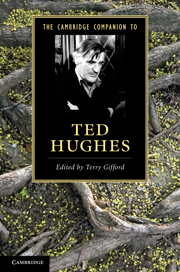Book contents
- Frontmatter
- Contents
- Acknowledgements
- Contributors
- Note on Referencing and Abbreviations
- Chronology
- Introduction
- 1 The problem of biography
- 2 The debates about Hughes
- 3 Hughes and animals
- 4 Ted Hughes and Sylvia Plath
- 5 The anthropologist’s uses of myth
- 6 Hughes’s social ecology
- 7 Hughes and feminism
- 8 Hughes and the classics
- 9 Hughes as prose writer
- 10 Hughes on Shakespeare
- 11 Class, war and the Laureateship
- 12 Hughes and his critics
- Guide to further reading
- Index
3 - Hughes and animals
Published online by Cambridge University Press: 28 July 2011
- Frontmatter
- Contents
- Acknowledgements
- Contributors
- Note on Referencing and Abbreviations
- Chronology
- Introduction
- 1 The problem of biography
- 2 The debates about Hughes
- 3 Hughes and animals
- 4 Ted Hughes and Sylvia Plath
- 5 The anthropologist’s uses of myth
- 6 Hughes’s social ecology
- 7 Hughes and feminism
- 8 Hughes and the classics
- 9 Hughes as prose writer
- 10 Hughes on Shakespeare
- 11 Class, war and the Laureateship
- 12 Hughes and his critics
- Guide to further reading
- Index
Summary
Hughes’s poetry from his first book to the last can be regarded as expressing one poet’s personal myth of his quest for what Keith Sagar has called ‘healing truths’ that both he himself and his society needed. For Hughes the poet, one way of achieving such insights is by taking a shamanistic approach to thinking and writing about animals. In one of his letters to Moelwyn Merchant in 1990, Hughes explains his long-standing interest in shamanism and the role of animals in it. He said that it was actually shamanism that had helped him see the connection between ‘everything that concerned [him]’, such as his ‘preoccupation with animal life’, his mythologies and a series of his recurring dreams (LTH 579). And underneath them all, what he found was a deeper connection between animal life and the divine world, a world that animals have always been living in and that humans are separated from, a world that is sometimes termed ‘the animal/spiritual consciousness’. In Hughes’s view, what he called ‘the divine being’ is the state of a shaman whose cultural ego has collapsed and who has then plunged back into an animal/spiritual consciousness that is not only his own, but that of his whole group.
- Type
- Chapter
- Information
- The Cambridge Companion to Ted Hughes , pp. 40 - 52Publisher: Cambridge University PressPrint publication year: 2011

